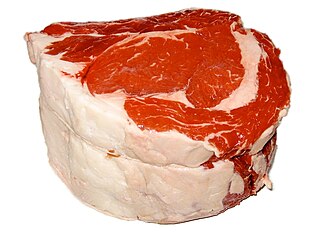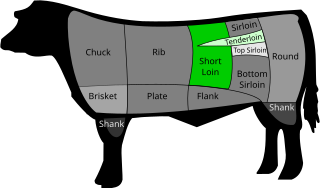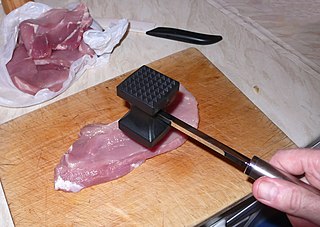Related Research Articles

Ham is pork from a leg cut that has been preserved by wet or dry curing, with or without smoking. As a processed meat, the term "ham" includes both whole cuts of meat and ones that have been mechanically formed.

Beef is the culinary name for meat from cattle.

Marinating is the process of soaking foods in a seasoned, often acidic, liquid before cooking. The origin of the word alludes to the use of brine in the pickling process, which led to the technique of adding flavor by immersion in liquid. The liquid in question, the marinade, can be either acidic or enzymatic, or have a neutral pH. In addition to these ingredients, a marinade often contains oils, herbs, and spices to further flavor the food items.

A beefsteak, often called just steak, is a flat cut of beef with parallel faces, usually cut perpendicular to the muscle fibers. In common restaurant service a single serving has a raw mass ranging from 120 to 600 grams. Beef steaks are usually grilled, pan-fried, or broiled. The more tender cuts from the loin and rib are cooked quickly, using dry heat, and served whole. Less tender cuts from the chuck or round are cooked with moist heat or are mechanically tenderized.

Teriyaki is a cooking technique used in Japanese cuisine in which foods are broiled or grilled with a glaze of soy sauce, mirin, and sugar.

The T-bone and porterhouse are steaks of beef cut from the short loin. Both steaks include a "T"-shaped lumbar vertebra with sections of abdominal internal oblique muscle on each side. Porterhouse steaks are cut from the rear end of the short loin and thus include more tenderloin steak, along with a large strip steak. T-bone steaks are cut closer to the front, and contain a smaller section of tenderloin. The smaller portion of a T-bone, when sold alone, is known as a filet mignon, especially if cut from the small forward end of the tenderloin.

Brisket is a cut of meat from the breast or lower chest of beef or veal. The beef brisket is one of the nine beef primal cuts, though the definition of the cut differs internationally. The brisket muscles include the superficial and deep pectorals. As cattle do not have collar bones, these muscles support about 60% of the body weight of standing or moving cattle. This requires a significant amount of connective tissue, so the resulting meat must be cooked correctly to tenderise it.
Bromelain is an enzyme extract derived from the stems of pineapples, although it exists in all parts of the fresh pineapple. The extract has a history of folk medicine use. As an ingredient, it is used in cosmetics, as a topical medication, and as a meat tenderizer.

Beef aging or ageing is a process of preparing beef for consumption by aging it, in order to break down the connective tissue within the meat.

Skirt steak is the US name for a cut of beef steak from the plate. It is long, flat, and prized for its flavor rather than tenderness. It is distinct from hanger steak (US), called skirt or onglet in Britain, a generally similar adjacent cut also from the plate.

Chuck steak is a cut of beef and is part of the sub-prime cut known as the chuck.

Doneness is a gauge of how thoroughly cooked a cut of meat is based on its color, juiciness, and internal temperature. The gradations are most often used in reference to beef but are also applicable to other types of meat.

Marbled meat is meat, especially red meat, that contains various amounts of intramuscular fat, giving it an appearance similar to marble.

A meat tenderizer or meat pounder is a hand-powered tool used to tenderize slabs of meat in the preparation for cooking. Although a meat tenderizer can be made out of virtually any object, there are three types manufactured specifically for tenderizing meat.

Ficain also known as ficin, debricin, or higueroxyl delabarre is a proteolytic enzyme extracted from the latex sap from the stems, leaves, and unripe fruit of the American wild fig tree Ficus insipida.

Basting is a cooking technique that involves cooking meat with either its own juices or some type of preparation such as a sauce or marinade. The meat is left to cook, then periodically coated with the juice.

A steak is a thick cut of meat generally sliced across the muscle fibers, sometimes including a bone. It is normally grilled or fried. Steak can be diced, cooked in sauce, such as in steak and kidney pie, or minced and formed into patties, such as hamburgers.

Zingibain, zingipain, or ginger protease is a cysteine protease enzyme found in ginger rhizomes. It catalyses the preferential cleavage of peptides with a proline residue at the P2 position. It has two distinct forms, ginger protease I (GP-I) and ginger protease II (GP-II).
Artificial marbling is the injection of animal fat or vegetable oil into lean meat in order to simulate the appearance of marbling and attempt to improve the palatability of inexpensive cuts by preventing them from drying out or losing flavour during the freezing or cooking process. Lean cuts of beef are one common target of artificial marbling. The process may also be performed on pork. It has been described as a more technologically advanced form of larding.
References
- 1 2 3 "Meat processing : Meat Qualities". Britannica. Retrieved 17 March 2016.
- ↑ Troy, D.J.; Kerry, J.P. (2010). "Consumer perception and the role of science in the meat industry". Meat Science. 86 (1): 214–226. doi:10.1016/j.meatsci.2010.05.009. PMID 20579814.
- 1 2 "The Meat Tenderness Debate". Natural Hub. Retrieved 17 March 2016.
- ↑ Luciano, F. B.; Anton, A.A; Rosa, C.F. (2007). "BIOCHEMICAL ASPECTS OF MEAT TENDERNESS: A BRIEF REVIEW" (PDF). Arch. Zootec. (56 (R): 1–8).
- ↑ Shackelford, S. D.; Wheeler, Ph.D., T. L. (2009). "Slice Shear Force" (PDF). Centennial, Colorado: National Cattlemen’s Beef Association USDA-ARS.
- ↑ Wheeler, Tommy L.; Shackelford, Steven D.; Koohmaraie USDA-ARS, Mohammad. "Warner-Bratzler Shear Force Protocol" (PDF). U.S. Meat Animal Research Center.
- 1 2 3 4 5 McGee, Harold (2004). ON FOOD AND COOKING, The science and lore of the kitchen. Scribner. p. 155. ISBN 978-0-684-80001-1.
- 1 2 3 LAROUSSE Gastronomique. Hamlyn. 2000. p. 1204. ISBN 978-0-600-60235-4.
- ↑ Madhusankha, G.D.M.P.; Thilakarathna, R.C.N. (2021). "Meat tenderization mechanism and the impact of plant exogenous proteases: A review". Arabian Journal of Chemistry. 14 (2): 102967. doi: 10.1016/j.arabjc.2020.102967 .
- ↑ Rossano, R.; Larocca, M.; Polito, T.; Perna, A. M.; Padula, M. C.; Martelli, G.; Riccio, P. (2012). "What Are the Proteolytic Enzymes of Honey and What They Do Tell Us? A Fingerprint Analysis by 2-D Zymography of Unifloral Honeys". PLOS ONE. 7 (11): e49164. Bibcode:2012PLoSO...749164R. doi: 10.1371/journal.pone.0049164 . PMC 3492327 . PMID 23145107.
- ↑ Yoon, J. W.; Lee, D. G.; Lee, H. J.; Choe, J.; Jung, S.; Jo, C. (2017). "Microbial, Physicochemical, and Sensory Characteristics of Quality Grade 2 Beef Enhanced by Injection of Pineapple Concentrate and Honey". Korean J Food Sci Anim Resour. 37 (4): 494–501. doi:10.5851/kosfa.2017.37.4.494. PMC 5599569 . PMID 28943761.
- ↑ "Tenderizing Meat with a Baking Soda Solution". Cook's Illustrated.
- ↑ Abrahams, Marc (5 December 2011). "Best way to tenderise meat? An underwater explosion". The Guardian .

